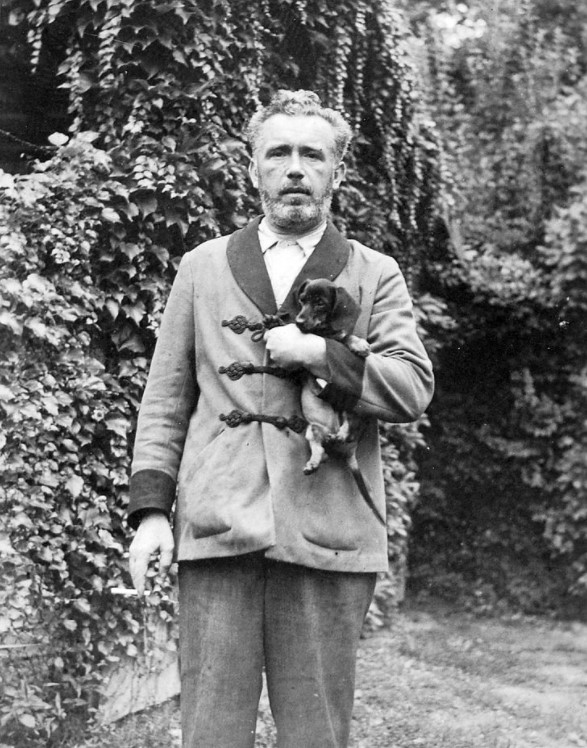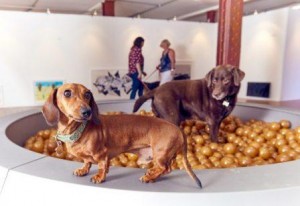
photo: Jankovszky György
source: wikipedia

Gerrard Gethings says: “Certain breeds would be essential because of their unique characteristics: Afghan hounds, poodles, pugs, bulldogs etc. I put out the word on social media and was inundated with dogs. I chose 10 of them and then set out to find their human counterpart.
To see the pictures click here to go to the Guardian
Fenella and Georgine, a saluki
“The plan was to shoot the dogs, find the humans, style them, then have them behave or pose in a similar way. This process would be repeated until we had all the shots. At the same time I would always have one eye on people I passed in the street. Many of the subjects I stopped in the park or on the bus, and had to find a tactful way of saying you look exactly like a poodle, can I take your photograph?
Henry and Hope, an Afghan hound
“Without exception, people reacted positively. I always led my request with a compliment, particularly if it was to a total stranger … ‘I’m working on a photographic project and you have beautiful hair/ interesting teeth/a magnificent nose!’ I’ve been taking photographs for a long time so am well versed in administering dubious compliments.
Amelia and Artemis, a standard poodle
“Almost all the dogs were funny. The giant Newfoundland had way too much love to give and almost killed my assistant, knocking her to the ground and cuddling her into submission. Our beautiful, competition winning, standard poodle was in hair and make-up for about two hours, and then the next dog turned up early. They took one look at each other and set off together, rolling and barking and generally going bonkers. The groomer was distraught. One dog mistook my tripod for a lamppost and every other dog who followed saw this as an invitation that would be rude to ignore.
Sophie and Percy, a pug
“During the casting process, I decided I simply had to photograph the Turkish man who helps out in my local shop. He has an amazing beard but speaks hardly any English. It was impossible to explain to him that he reminds me of a miniature schnauzer. I gave up in the end but wrote down the studio address and a time on a piece of paper. He showed up anyway, with absolutely no idea what was about to happen. His pictures were great.”
And more…
(To read the full article with pictures go to The Guardian.)
From Picasso to Warhol, dachshunds have been the constant companion of creative types. Sausage dog enthusiast David Capra explains why…
My muse is a seven-year-old chocolate and tan sausage dog. I was captivated by Teena when she was a pup: ears that moved like a tiny elephant’s, a seal-jolting head and platypus feet pitter-pattering along, trying to get hold of my laces. Before we met I made sculptures called Prayers for Sausage Dog; one such work was a three-headed dachshund contraption the tail of which I vigorously turned in hope it would summon such a creature. It seems to have worked: Teena was rescued from a puddle of mud under a house in Nyngan, in the Bogan shire of New South Wales.
Teena is named after a Tena Pad, a Swedish-based urinary incontinence product. She was christened with her name by virtue of her shape – she distinctly resembles one of those great inventions of absorbency. In addition, Teena often greets strangers with a rolling operation, landing on her back, presenting a memento of the happy occasion: a small tinkle.
n 2016, Teena launched her own fragrance, Eau de Wet Dogge, on Australian breakfast television with a smell-o-vision segment with Karl Stefanovic and Lisa Wilkinson. In 2014, Teena’s Bathtime was launched at the Museum of Contemporary Art’s Bella room, where audiences were invited to help bathe a large sculpture of Teena. Visitors grew so attached to the room-sized zigzagging Teena installation that some had to be consoled when she was packed away. Visitors related to Teena’s experiences around anxiety (Teena doesn’t enjoy bath time). Some wrote letters of advice to her, for example: “Get over it, it’s only a bath”, and “Baths will keep you smelling fresh. Maybe start with soaking your paws.”
Last year, I embarked on a global self-funded “saus tour”, documenting sausage dogs I encountered on footpaths. In New York, I met Katy Dobbs, who had been the longstanding editor-in-chief of Muppet Magazine. “I got a weiner dog of my own after falling in love with a close friend’s [dog],” she said. That friend had been Andy Warhol.
Warhol and his tan short-haired Archie were inseparable, Dobbs told me. It wouldn’t be uncommon for the artist to switch attention to Archie during interviews or make an appearance at Studio 54, paw in hand.
“Archie was a mirror of his boss,” says Jamie Wyeth, who made oil paintings of the pair. “He’d sit there and stare at people. And just like Andy, he didn’t say a word.”
In 1957, American photographer David Douglas Duncan and his pet dachshund, Lump, set off in his Mercedes Gullwing 300 SL to visit Pablo Picasso in the Villa La Californie, near Cannes. Used to living in a cramped Rome apartment, Lump liked Picasso’s endless rooms and Esmeralda, the artist’s pet goat, so much that he decided to stay. The Marriage of Lolita and Lump chapter in Duncan’s book, Lump: The Dog Who Ate a Picasso, shows Lump’s first meeting with a lady dachshund. Picasso can be seen helping the two consummate their marriage. (On a related note, a friend of mine used to be employed to assist dachshunds to mate. “Their bodies don’t quite meet up, you see,” my friend told me, “so they needed an extra pair of hands.”)
Soon after Lump’s arrival, Picasso commemorated their first lunch together by inscribing in ink the dog’s outstretched silhouette on a porcelain plate. A photograph shows the moment immediately afterwards, with Picasso’s fishbone spread across his mouth and Lump’s yearning eyes looking on.
Lump was a constant companion of Picasso, the two dying only days apart. Duncan says of their bond: “When Picasso looked at Lump a sweet gentleness glowed in his eyes. Once he said, ‘Lump has the best and worst in us!’.”
American painter William N Copley is another notable artist seduced by the dachshund. His four-legged friend would pop up in painted scenes alongside car accidents, meat grinders, nude women and patterned interiors. French avant garde artist Pierre Bonnard tenderly rendered his dachshund with a few scarce brush marks, seated in rooms of yellow and magenta, or on someone’s lap at dinner.
Ruthie, the pup of German expressionist Franz Marc, is depicted in Dog Lying in the Snow, voted the Städel Museum’s most popular painting in 2008. We can’t be sure if the dog depicted is of the dachshund breed, but it does bear those familiar triangular ears and elongated log body. According to Marc, animals are the only innocent and pure creatures left in this corrupted world. Though, if he truly believed that, it is unlikely he ever encountered the headstrong and mischievous dachshund.
In Alba, northern Italy, I came face to face with futurist Giacomo Balla’s Dynamism of a Dog on a Leash. This masterpiece presents a dachshund with multiple paws a’ flapping looking somewhat between a well-oiled machine and progress itself, as it purposefully walks down the street. Only hours earlier on the flight over, I watched how Jim Carrey’s character on The Truman Show learns his entire life is a 24-hour-a-day TV program. During the realisation sequence, a dachshund is seen raging the road, its leash tumbling in the wind and sausage body zipping across the frame.
Another pit stop on the saus tour was meeting New York dog artist William Wegman, known for his collaborations with weimaraners, like Fay Ray, the “supermodel dog” who counted balls on Sesame Street. Wegman now works with Flo and Topper, the half-brother and sister duo. Fresh from their photo shoot with Vogue, I presented them with Eau de Wet Dogge, a gift from Teena. The kitchen became a beastly whirlwind mass of grey as the two circled the scent. Flo and Topper then demonstrated how they balanced on their famed white plinths. I saw the same level of bodily pose and focus that sweeps across Teena’s face when the camera makes an appearance. Some dogs, more than others, are made for show business, yet all the dachshunds I know go about life like they are continually in the spotlight.
Next on the saus tour list is the brand new Dackelmuseum in Passau, Germany. Of particular interest is what appears to be a stuffed half dachshund, half Komodo dragon on display.
Australian artist Bennett Miller is no stranger to the sausage dog form, staging the work Dachshund UN across the globe. Here, delegates were replaced by real dachshunds in a to-scale tiered model of the United Nations commission on human rights assembly.
“I was looking at this idea of form following function and the dachshund form is sort of strange because it’s very divorced from its function,” Miller said in 2012. “The dachshund [is] a good metaphor for the UN, mostly because of the restricted form [of] their tiny legs …[looking] proud and determined.” For one hour, little dogs barked into microphones seated behind country name placards. Pure joy and mania.
British painter David Hockney, known for his fashionable ensembles of stripes, bow ties and smart trousers, was often seen with dachshunds Stanley and Boodgie. The two would regularly be found in Hockney’s studio, sitting on their cushions, snuggling up to each other as they watched each brushstroke. They complement the picture, not unlike the handsome Daki the dachshund in Jacques Tati’s 1958 slapstick comedy, Mon Oncle. Dressed in tartan print, the family pet appears to be of the same make as the modernist furnishings populating the sets.
Stanley and Boogie have had an entire picture book, Dog Days, dedicated to their laying about. “I notice the warm shapes they make together, their sadness and their delights,” Hockney writes. “And being Hollywood dogs, they somehow know that a picture is being made.” The Hollywood Hills is a far cry from barking at badgers in the countryside, which is what the dachshund was originally bred for.
What makes a dachshund so adored by artists? Maybe it’s because a sausage dog is the only match for an artist’s ego. The dachshund sure is an authority when it comes to singlemindedness. They see the world for what it is: theirs and for the taking. Teena demonstrated this recently when, before presenting to a TEDx audience of 5000, she developed a reputation backstage for all her barking – so much that a sign was hung on her dressing room: “Please knock with only two gentle knocks. Enter with caution.”
The Kennel Club has announced the winners of its Dog Photographer of the Year competition. Monica van der Maden was the overall winner with an image of Noa the Great Dane seemingly alone in a forest…
Click here for the Dog Photographer of the Year 2018
British inventor, artist and satirist Dominic Wilcox is at it again, this time with a contemporary art exhibition aimed at canine attendees with a range of interactive installations purpose-built for pups.
Play More in London has an array of dog-oriented artworks set low on the gallery walls as well as other more directly experiential displays.

A series of images by Slovenian photographer Katja Jemec, I Looked Up and There You Were, has an unusual angle on rescued dogs:
A new craze called Fleece Dog is sweeping across Britain…
Do dogs really look like their owners? They do in this project by Swiss photographer Sebastian Magnani – he has spliced together portraits of the owners with their four-legged friends in a series called Underdogs.